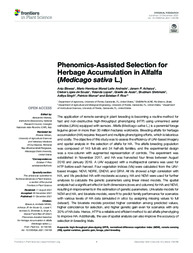Phenomics-assisted selection for herbage accumulation in alfalfa (Medicago sativa L.).
Phenomics-assisted selection for herbage accumulation in alfalfa (Medicago sativa L.).
Autoria: BISWAS, A.; ANDRADE, M. H. M. L.; ACHARYA, J. P.; SOUZA, C. L. de; LOPEZ, Y.; ASSIS, G. M. L. de; SHIRBHATE, S.; SINGH, A.; MUNOZ, P.; RIOS, E. F.
Resumo: The application of remote sensing in plant breeding is becoming a routine method for fast and non-destructive high-throughput phenotyping (HTP) using unmanned aerial vehicles (UAVs) equipped with sensors. Alfalfa (Medicago sativa L.) is a perennial forage legume grown in more than 30 million hectares worldwide. Breeding alfalfa for herbage accumulation (HA) requires frequent and multiple phenotyping efforts, which is laborious and costly. The objective of this study was to assess the efficiency of UAV-based imagery and spatial analysis in the selection of alfalfa for HA. The alfalfa breeding population was composed of 145 full-sib and 34 half-sib families, and the experimental design was a row-column with augmented representation of controls. The experiment was established in November 2017, and HA was harvested four times between August 2018 and January 2019. A UAV equipped with a multispectral camera was used for HTP before each harvest. Four vegetation indices (VIs) were calculated from the UAVbased images: NDVI, NDRE, GNDVI, and GRVI. All VIs showed a high correlation with HA, and VIs predicted HA with moderate accuracy. HA and NDVI were used for further analyses to calculate the genetic parameters using linear mixed models. The spatial analysis had a significant effect in both dimensions (rows and columns) for HA and NDVI, resulting in improvements in the estimation of genetic parameters. Univariate models for NDVI and HA, and bivariate models, were fit to predict family performance for scenarios with various levels of HA data (simulated in silico by assigning missing values to full dataset). The bivariate models provided higher correlation among predicted values, higher coincidence for selection, and higher genetic gain even for scenarios with only 30% of HA data. Hence, HTP is a reliable and efficient method to aid alfalfa phenotyping to improve HA. Additionally, the use of spatial analysis can also improve the accuracy of selection in breeding trials.
Ano de publicação: 2021
Tipo de publicação: Artigo de periódico
Unidade: Embrapa Acre
Palavras-chave: Alfafa, Fitomejoramiento, Forage legumes, Genetic gain, High-throughput phenotyping (HTP), Leguminosa Forrageira, Leguminosas forrajeras, Medicago Sativa, Melhoramento Genético Vegetal, Normalized difference vegetation index (NDVI), Phenotype, Plant breeding, Remote sensing, Sensoriamento Remoto, Spatial variation, Teledetección, Variación espacial
Observações
1 - Por padrão são exibidas publicações dos últimos 20 anos. Para encontrar publicações mais antigas, configure o filtro ano de publicação, colocando o ano a partir do qual você deseja encontrar publicações. O filtro está na coluna da esquerda na busca acima.
2 - Para ler algumas publicações da Embrapa (apenas as que estão em formato ePub), é necessário ter, no celular ou computador, um desses softwares gratuitos. Sistemas Android: Google Play Livros; IOS: iBooks; Windows e Linux: software Calibre.
Acesse outras publicações
Acesse a Base de Dados da Pesquisa Agropecuária (BDPA) para consultar o acervo completo das bibliotecas da Embrapa.

